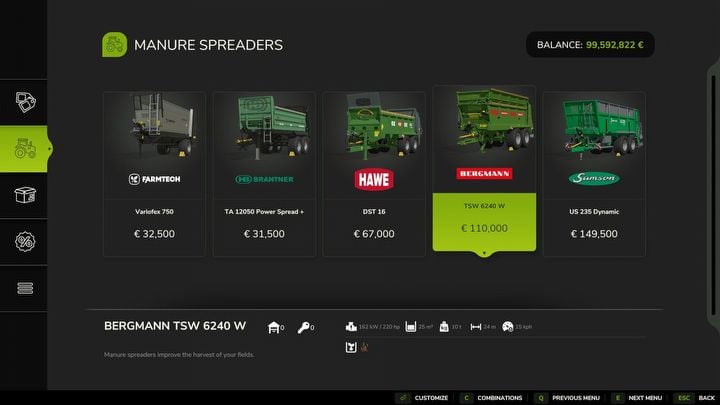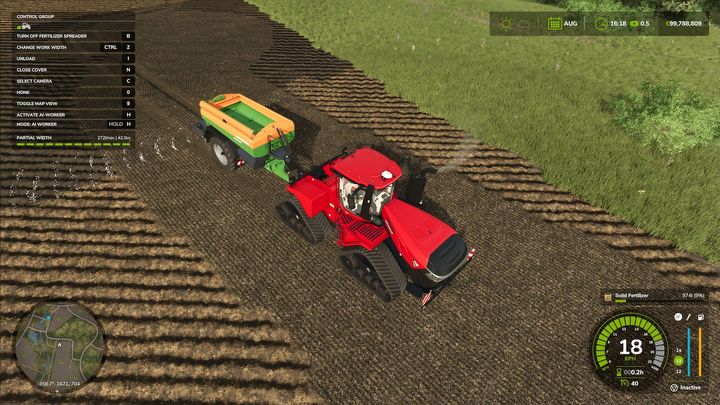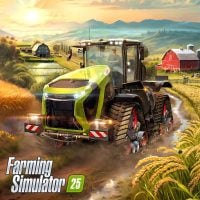Farming Simulator 25: Fertilizing
Fertilizing fields is key to achieving high yields in Farming Simulator 25. On this page of the guide, we describe when to fertilize fields and the types of fertilizer.
Last update:
Fertilizing is a key process in Farming Simulator 25. As you've probably expected, fertilizing fields significantly increases the amount of crops when it's time for harvest. That's why this is an extremely important task, thanks to which you will maximize your profits. On this page of the guide we have described when to fertilize the fields and what types of fertilizers you can choose from.
When to fertilize fields?
Just like in the previous games, you should carry out the fertilization process on each field twice, after sowing. However, the fertilizer needs some time to soak into the soil. Fertilize once per growing season (it is visible in a frame in the corner of the screen after you go into the field; when the growing season changes, you can spread the fertilizer again). Fertilizing more than twice or more than once during the same growth period is a waste of time and resources. The only exceptions are manure and slurry described below, which allow for double fertilization in one cycle.
What are the types of fertilizers?
The game contains six types of fertilizers. Although they differ slightly from each other, they all come with the same effects when it comes to fertilizing the fields. Fertilizers are also distributed with various machines, so pay attention to their descriptions in the store. These are the available fertilizers:
- Manure – solid organic fertilizer. It is produced by pigs and cows, which means that by raising these animals you will have constant access to it. You can spread it with a manure spreader. This machine has a double fertilization function; activating it will allow you to double fertilize with a single pass.
- Slurry - liquid organic fertilizer. It is produced by pigs and cows, which means that by breeding these animals you will have constant access to it. You can distribute it with the help of a sanitation truck. This machine has a double fertilization function; activating it will allow you to double fertilize with a single pass.
- Artificial fertilizer - solid artificial fertilizer. You can buy it in the store. You can spread it with a fertilizer spreader. It's a universally good option, as fertilizer spreaders are quite cheap. It will be useful to you especially at the beginning of the game.
- Chemical spray - liquid fertilizer. You can buy it in the store. You can distribute it with the help of sprayers. This is an option you can look into later - sprayers are expensive, but they also allow you to distribute the herbicides needed for the weeding process.
- Digestate - liquid organic fertilizer. It is a by-product obtained for delivering silage, manure or slurry to biogas plants. You can distribute it with the help of a sanitation truck. Since you need a constant inflow of manure and slurry as well as a built biogas plant to obtain it, digestate becomes optimal quite late in the game. However, this is a free fertilizer that you receive by performing a completely different activity, so it is worth using it on an ongoing basis.
- Oilseed radish - a completely unique fertilizer. This is a plant that you can plant in the soil right after harvest and before plowing or cultivation. The radish grows for one month and once it grows, you have to plow or cultivate it. This will destroy the radish and distribute it inside the soil, which counts as a single fertilization process. While it can only be used once per cycle and requires more work to plant, it will help you reduce your fertilization costs early in the game.
- Farming Simulator 25 Guide
- Farming Simulator 25: Game Guide
- Farming Simulator 25: Cultivation of plants
- Farming Simulator 25: Order of field work
- Farming Simulator 25: Plowing
- Farming Simulator 25: Cultivation
- Farming Simulator 25: Lime spreading
- Farming Simulator 25: Stone picking and soil rolling
- Farming Simulator 25: Sowing and planting
- Farming Simulator 25: Weeding
- Farming Simulator 25: Fertilizing
- Farming Simulator 25: Harvesting
- Farming Simulator 25: Mulching
- Farming Simulator 25: Straw
- Farming Simulator 25: How to grow grass?
- Farming Simulator 25: How to make hay?
- Farming Simulator 25: Storing resources
- Farming Simulator 25: How to grow grains?
- Farming Simulator 25: How to grow potatoes?
- Farming Simulator 25: How to grow sugar beets?
- Farming Simulator 25: How to grow sunflowers and corn?
- Farming Simulator 25: How to grow sugarcane?
- Farming Simulator 25: How to cultivate long grain rice?
- Farming Simulator 25: How to grow rice?
- Farming Simulator 25: How to grow root vegetables - carrots, parsnip, red beet?
- Farming Simulator 25: How to grow grapes and olives?
- Farming Simulator 25: Cultivation of plants
- Farming Simulator 25: Game Guide
You are not permitted to copy any image, text or info from this page. This site is not associated with and/or endorsed by the developers and the publishers. All logos and images are copyrighted by their respective owners.
Copyright © 2000 - 2025 Webedia Polska SA for gamepressure.com, unofficial game guides, walkthroughs, secrets, game tips, maps & strategies for top games.


